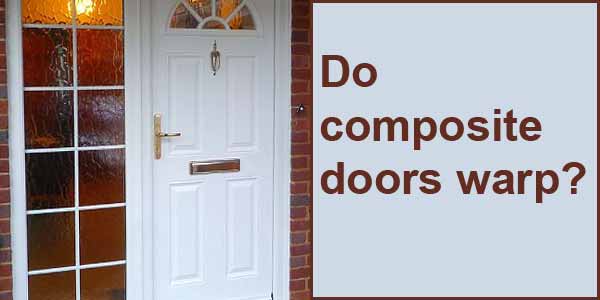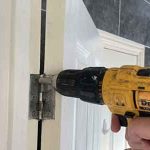Composite doors are a modern type of external door. They offer an alternative to other materials, such as solid wood and uPVC. They are made with a combination of materials, including a solid core, that is usually either solid wood or an engineered wood.
The solid core is then covered with insulating foam and a layer of glass reinforced plastic (GRP). Occasionally uPVC is used for the finished surface. However GRP is a superior material.

Overall, composite doors are considered highly durable, and they have many benefits over solid wood and uPVC.
Additional benefits of composite doors include:
- Enhanced security
- Better insulation
- Low maintenance
- Weather resistance
- Customizable aesthetics
- Resistance to warping
Whilst it is possible for a composite door to warp, it is far less common than movement in wood and uPVC doors. Due to the combination of materials used in a composite door, they are far less prone to warping. However, it is still possible to a small extent, with extreme fluctuations in temperature and moisture.
Warping in composite doors vs Solid wood
Solid wooden doors are much more prone to warping and other types of movement. This is mainly due to wood being a natural material.
Because wood is a natural material, it always contains a certain level of moisture content. This means the door can expand and contract as moisture levels in the wood change. These fluctuations are the result of humidity and temperature.
In the UK, you will often find that wooden doors swell in the wet winter months. Following this, they will contract as temperatures rise in spring and summer. This can result in a door that sticks, as well as issues with latching and locking.
The moisture fluctuations can be reduced significantly by maintaining the door. For example, a well-sealed and painted door, with no exposed wood, will be far less prone to movement.
Most composite doors, also contain a significant amount of wood. This forms the core of the door, which can be solid wood, or some form of engineered particle board. Either way, just like a solid wood door this material will naturally contain a small level of moisture.
However, the wood core is sealed inside the door by the outer door finish (GRP for example). This is a watertight seal, meaning the core does not suffer with the same fluctuations found in solid wood doors.
It is important to point out, that a badly made door, or damage to the composite, could expose the core to additional moisture. This could result in the potential for additional movement.
Warping in composite doors vs uPVC
Whilst composite and uPVC doors often look similar, a composite door is a much higher quality product. It has a solid core, which makes it much more durable and secure. Also, the outer finish of the door is usually GRP, as opposed to uPVC. Again this is a superior product.
As a result, uPVC doors are more prone to warping. However, unlike wood doors, this is not due to moisture, instead it is caused by fluctuations in temperature.
Both materials are very resilient to fluctuations in temperature, but GRP is far more resistant.
uPVC is a more rigid and durable version of PVC. Standard PVC contains plasticizers, which make it more flexible. This means it will distort easier when exposed to high temperatures and prolonged direct sunlight.
With these plasticizers removed, uPVC is more resistant to warping. However, this type of plastic can still expand and contract with significant temperature changes.
Glass Reinforced Plastic, or GRP (also known as fiberglass) is a completely different material. It is made using a combination of plastic resin and glass fibres. This makes it far more resilient to temperature changes. As a result, it is less prone to warping when compared with uPVC.
Impact of Incorrect Closure on Composite Door Warping
When a composite door is not closed correctly, it can put stress on the door and its components. Consistently slamming the door, or leaving it ajar for extended periods, can contribute to warping or other issues.
This can also lead to misalignment within the frame, causing difficulties in opening, closing, or locking the door. Also, improper closure could damage the weatherstripping, which may result in air leakage or water ingress, increasing the risk of warping.
To mitigate these potential issues, you should close the door correctly by lifting the handle to engage the doors mechanism. By doing this, you secure the door in place and reduce strain on the components.
It is also important to carry out regular inspection and maintenance. This includes addressing any issues promptly to prevent long-term damage or warping.
For example, if you are having difficulties opening and closing the door, or if it’s not locking correctly, this could be due to an issue with things like:
- Handles
- Locks
- Hinges.
Over time, these can all suffer from wear and tear, which can make them become lose or even complete break. If this is the case, they may require adjusting, or maybe even full replacement.
Conclusion
As you can see, it is possible for a composite doors to warp. However, it is not that common, when compared with single materials doors, such as wood and uPVC.
As we have discussed, both wood and uPVC can warp more easily. Although, they do warp for completely different reasons.
Wood warping is mainly due to moisture, and uPVC is more related to extreme temperatures.
If you are having issues with your composite door, you should also consider other reasons, such as misalignment or faulty hardware.
When in doubt you should talk with the person that fitted your doors, or another local professional.
Someone who knows what they are doing, will be able to fix most issues relating to misalignment, wear and tear, and even minor warping.




